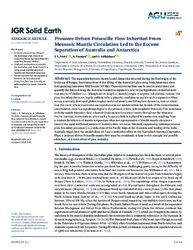Pressure‐Driven Poiseuille Flow Inherited From Mesozoic Mantle Circulation Led to the Eocene Separation of Australia and Antarctica
Stotz, I. L.; Tassara, A.; Iaffaldano, G., 2021: Pressure‐Driven Poiseuille Flow Inherited From Mesozoic Mantle Circulation Led to the Eocene Separation of Australia and Antarctica. In: Journal of Geophysical Research: Solid Earth, Band 126, 4, DOI: 10.23689/fidgeo-4366.
 |
Dokument öffnen: |
The separation between Australia and Antarctica occurred during the final stages of the break‐up of Pangea. Reconstructions of the rifting of the Australian plate away from Antarctica show fast spreading rates since Mid‐Eocene (45 Ma). These reconstructions can be used to understand and quantify the forces driving the Australia/Antarctica separation, and to test hypotheses on mechanisms that may be of shallow (i.e., lithosphere) or deep (i.e., mantle) origin. Analytical calculations indicate that plate‐boundary forces are highly unlikely to be a plausible candidate to explain such a separation. Thus, we use a recently developed global coupled models of mantle and lithosphere dynamics, here we show that this event, whose kinematics are reproduced in our models within the bounds of the reconstruction uncertainties, owes to a significant degree to the pressure‐driven asthenospheric Poiseuille flow associated with the mantle buoyancy field inherited from viscous circulation history throughout the Mesozoic. On the contrary, in simulations when such a buoyancy field is replaced by another one resulting from a random distribution of mantle temperature–thus not representative of Earth’s mantle circulation history–the rapid northward motion of Australia does not occur. Similarly, suppressing contemporaneous plate‐boundary processes (i.e., subduction of the Pacific ridge at the Aleutians and healing of the India‐Australia ridge) from our models does not have a noticeable effect on the Australia‐Antarctica kinematics. Thus, a pressure‐driven Poiseuille mantle flow must be considered, at least in this example and possible elsewhere, as a main driver of plate tectonics. Key Points:
Reconstructions of the rifting of the Australian plate away from Antarctica shows fast spreading rates since Mid‐Eocene (45 Ma).
Analyzed mechanisms to separate the Australian plate from Antarctica using coupled global models of mantle and lithosphere dynamics.
Results indicate that the separation between the Australian and Antarctica plate was driven by an asthenospheric pressure Poiseuille flow.
Statistik:
ZugriffsstatistikSammlung:
Schlagworte:
mantle circulation historypressure‐driven Poiseuille flow
separation of Australia/Antarctica
This is an open access article under the terms of the Creative Commons Attribution License, which permits use, distribution and reproduction in any medium, provided the original work is properly cited.

